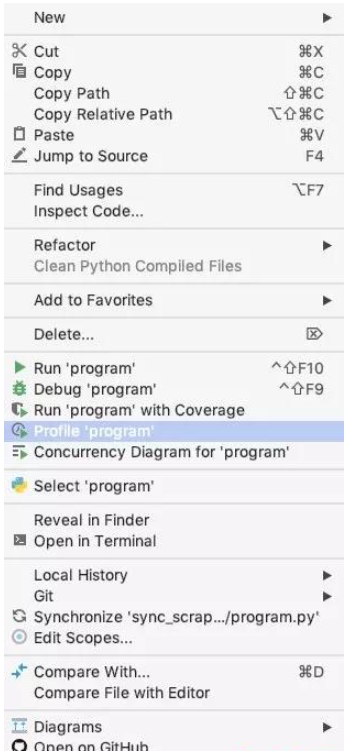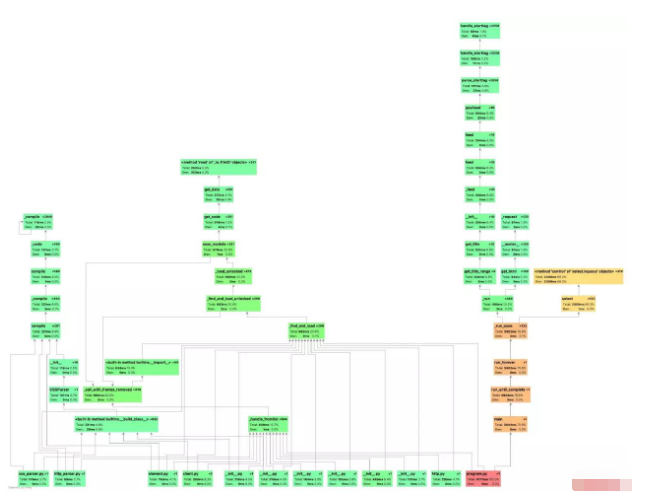您好,登錄后才能下訂單哦!
您好,登錄后才能下訂單哦!
這篇文章主要介紹“怎么使用PyCharm Profile分析異步爬蟲效率”的相關知識,小編通過實際案例向大家展示操作過程,操作方法簡單快捷,實用性強,希望這篇“怎么使用PyCharm Profile分析異步爬蟲效率”文章能幫助大家解決問題。
第一個代碼如下,就是一個普通的 for 循環爬蟲。原文地址。
import requests
import bs4
from colorama import Fore
def main():
get_title_range()
print("Done.")
def get_html(episode_number: int) -> str:
print(Fore.YELLOW + f"Getting HTML for episode {episode_number}", flush=True)
url = f'https://talkpython.fm/{episode_number}'
resp = requests.get(url)
resp.raise_for_status()
return resp.text
def get_title(html: str, episode_number: int) -> str:
print(Fore.CYAN + f"Getting TITLE for episode {episode_number}", flush=True)
soup = bs4.BeautifulSoup(html, 'html.parser')
header = soup.select_one('h2')
if not header:
return "MISSING"
return header.text.strip()
def get_title_range():
# Please keep this range pretty small to not DDoS my site. ;)
for n in range(185, 200):
html = get_html(n)
title = get_title(html, n)
print(Fore.WHITE + f"Title found: {title}", flush=True)
if __name__ == '__main__':
main()這段代碼跑完花了37s,然后我們用 pycharm 的 profiler 工具來具體看看哪些地方比較耗時間。
點擊Profile (文件名稱)

之后獲取到得到一個詳細的函數調用關系、耗時圖:

可以看到 get_html 這個方法占了96.7%的時間。這個程序的 IO 耗時達到了97%,獲取 html 的時候,這段時間內程序就在那死等著。如果我們能夠讓他不要在那兒傻傻地等待 IO 完成,而是開始干些其他有意義的事,就能節省大量的時間。
稍微做一個計算,試用asyncio異步抓取,能將時間降低多少?
get_html這個方法耗時36.8s,一共調用了15次,說明實際上獲取一個鏈接的 html 的時間為36.8s / 15 = 2.4s。**要是全異步的話,獲取15個鏈接的時間還是2.4s。**然后加上get_title這個函數的耗時0.6s,所以我們估算,改進后的程序將可以用 3s 左右的時間完成,也就是性能能夠提升13倍。
再看下改進后的代碼。原文地址。
import asyncio
from asyncio import AbstractEventLoop
import aiohttp
import requests
import bs4
from colorama import Fore
def main():
# Create loop
loop = asyncio.get_event_loop()
loop.run_until_complete(get_title_range(loop))
print("Done.")
async def get_html(episode_number: int) -> str:
print(Fore.YELLOW + f"Getting HTML for episode {episode_number}", flush=True)
# Make this async with aiohttp's ClientSession
url = f'https://talkpython.fm/{episode_number}'
# resp = await requests.get(url)
# resp.raise_for_status()
async with aiohttp.ClientSession() as session:
async with session.get(url) as resp:
resp.raise_for_status()
html = await resp.text()
return html
def get_title(html: str, episode_number: int) -> str:
print(Fore.CYAN + f"Getting TITLE for episode {episode_number}", flush=True)
soup = bs4.BeautifulSoup(html, 'html.parser')
header = soup.select_one('h2')
if not header:
return "MISSING"
return header.text.strip()
async def get_title_range(loop: AbstractEventLoop):
# Please keep this range pretty small to not DDoS my site. ;)
tasks = []
for n in range(190, 200):
tasks.append((loop.create_task(get_html(n)), n))
for task, n in tasks:
html = await task
title = get_title(html, n)
print(Fore.WHITE + f"Title found: {title}", flush=True)
if __name__ == '__main__':
main()同樣的步驟生成profile 圖:

可見現在耗時為大約3.8s,基本符合我們的預期了。

關于“怎么使用PyCharm Profile分析異步爬蟲效率”的內容就介紹到這里了,感謝大家的閱讀。如果想了解更多行業相關的知識,可以關注億速云行業資訊頻道,小編每天都會為大家更新不同的知識點。
免責聲明:本站發布的內容(圖片、視頻和文字)以原創、轉載和分享為主,文章觀點不代表本網站立場,如果涉及侵權請聯系站長郵箱:is@yisu.com進行舉報,并提供相關證據,一經查實,將立刻刪除涉嫌侵權內容。